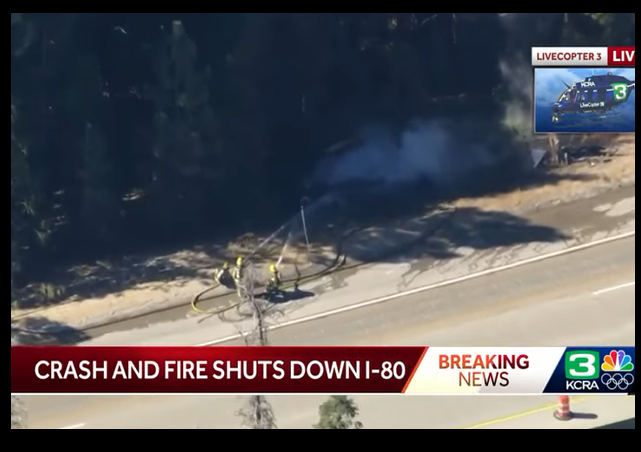Hazmat Crews Fight Electric Truck Battery Fire That Closes California’s I-80

There is an interesting new entry for my series on electric vehicle realities.
As I have noted, many challenges are associated with fighting lithium/lithium-ion battery fires. The lithium is water reactive, yet water is often the only fire-fighting option in large enough quantities to fight the blaze. The materials burn at very high temperatures and are prone to re-igniting, which is why it took the firefighters in Texas 30,000 gallons of water and four hours to extinguish one blaze.
In my most recent report on the issue, a San Diego area warehouse collection of batteries burned for nearly a week before firefighters began to control the fire. Even then, the fire continued to smolder for weeks.
Now, an electric big-rig truck fire forced hazmat crews to shut down both directions of Interstate 80 in Northern California’s Sierra Nevada as authorities battled the intense heat and toxicity from the vehicle’s batteries.
The crash occurred around 3:15 a.m. near Emigrant Gap where an electric vehicle traveling eastbound at the Laing Road offramp crashed onto the right shoulder and into trees, according to the California Highway Patrol’s incident log.Officer Jason Lyman, a spokesman for the CHP’s Gold Run office, said that only one vehicle was involved and that the driver was not injured. Lyman said the white Tesla Semi truck was without a trailer when it was headed uphill west of Yuba Gap. Investigators were still trying to piece together what led the Tesla to leave the roadway, he said.But authorities’ immediate concern was the fire, sparked by the batteries of the roughly 13-ton vehicle, after the vehicle was seen “smoking.” Lyman said that the fire produced “quite the plume of smoke” early on as firefighters rushed in to fight the flames with chemicals. By 9 a.m. the fire was still smoldering, Lyman said.
Keep in mind that electric trucks are being mandated under California regulations.
As of January 1, 2024, any new big rigs registered in California have to be powered by hydrogen or electricity. California’s Advanced Clean Fleets Regulation, which the California Air Resources Board approved on April 28, mandates that companies rapidly phase out diesel semi-trucks, starting with older models, and replace them with zero-emission trucks.
Given this incident, I suspect California truckers who own diesel rigs will bitterly cling to their machines for as long as possible.
The incident report adds additional perspective on the challenges of dealing with this type of fire. The evacuation perimeter was one-half mile. The firefighters had to use helicopters, as they would do when battling a wildfire.
Even after battling the blaze for 8 hours, one lane of traffic was still not open.
“The battery itself, you can’t just spray water on it to put it out. It takes either some sort of dry chemical or very huge amount of water, I’ve heard as much as 40,000 gallons,” said Ofc. Jason Lyman with CHP Gold Run.It’s unknown what the semi was hauling.CHP initially said they expected the roadway to reopen around 8 a.m. Monday, but the freeway remained fully closed through the late afternoon. As of 4:30 p.m., the westbound lanes had been reopened but there was still no clear indicator for when the eastbound side would reopen.Cal Fire aircraft dropped fire retardant on the semi, like during a wildfire fight, to keep the flames under control.The eastbound lanes are closed at Nyack. CHP says all big rigs are being turned around eastbound at Applegate.The incident started as a crash when the big rig went off the roadway and into the trees.
Tens of thousands of gallons of water, toxic fumes, and cars idling during the closure—all of this environmental goodness is brought to you by green energy.
CLICK HERE FOR FULL VERSION OF THIS STORY